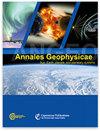太阳周期对太阳风参数与地磁条件之间非线性关系的影响
IF 1.9
4区 地球科学
Q3 ASTRONOMY & ASTROPHYSICS
引用次数: 0
摘要
摘要太阳风及其瞬变驱动着地球磁层的动态变化。行星际日冕物质抛射(ICMEs)在近地空间引起的变化最大,但高速流(HSSs)和流相互作用区(SIRs)也能驱动显著的地磁活动。太阳风与磁层的相互作用可能会导致内部磁层的波动,从而对外部辐射带的电子产生影响。在这项研究中,我们利用信息论中的互信息来研究太阳风参数与内磁层指数(包括 Pc5 范围内的超低频(ULF)波和外辐射带中的电子)之间的统计依赖关系在太阳周期 23(1998-2008 年)期间的变化。与皮尔逊相关系数不同,互信息可用于研究不同参数之间的非线性统计依赖关系。我们分别计算了太阳周期 23 期间每年的线性和非线性相关系数,并用线性相关系数和非线性相关系数之比来定义非线性。我们发现,太阳风速与电子通量指数之间的非线性关系在太阳极大期较高,因为此时大部分地磁活动是由国际集成电磁系统驱动的;而在太阳极小期,非线性关系则会降低,因为此时地磁活动的大部分是由高频和中频驱动的。另一方面,在地磁活动较强的时段,IMF Bz 和太阳风电场 Ey = VswBz 与地磁指数的非线性关系较小。为了进一步研究作为地磁活动驱动力的集成电磁脉冲和红外/短波的比例变化是否是太阳周期非线性变化的可能原因,我们分别计算了集成电磁脉冲、红外/短波和静止太阳风期间的相关系数。我们发现,太阳风速度与内磁层电子通量和超短波指数的非线性最小,相关性(包括线性和非线性)最高,因此,在静风期间非线性最小,而所研究的其他太阳风参数在HSS或ICME期间的相关性更好。这些结果表明,相关性分析所选的时间段(太阳周期的阶段、所选时间内地磁活动的主要驱动因素)会对结果产生重大影响。结果还表明,在集成电磁脉冲事件期间,所研究的大多数太阳风-磁层指数参数对(速度、密度、动压)的太阳风-磁层耦合变得更加非线性,但在地磁活动较强的时段,IMF Bz 和太阳风电场 Ey = VswBz 的非线性较小。本文章由计算机程序翻译,如有差异,请以英文原文为准。
Impact of solar cycle on the non-linearity of the relationship between the solar wind parameters and geomagnetic conditions
Abstract. Solar wind and its transients drive the dynamics of Earth’s magnetosphere. Interplanetary coronal mass ejections (ICMEs) induce the largest variations in the near-Earth space, but significant geomagnetic activity can also be driven by high-speed streams (HSSs) and stream interaction regions (SIRs). Solar wind – magnetosphere interaction may lead to fluctuations in the inner magnetosphere and, hence, impact the electrons in the outer radiation belt. In this study, we use mutual information from information theory to study the change in the statistical dependence between solar wind parameters and inner magnetospheric indices including ultra low frequency (ULF) waves in the Pc5 range and electrons in the outer radiation belt during solar cycle 23 (1998–2008). Unlike Pearson correlation coefficient, mutual information can be used to investigate non-linear statistical dependencies between different parameters. We calculate linear and non-linear correlation coefficients separately for each year during solar cycle 23 and define the non-linearity with the ratio between the linear and non-linear correlation coefficients. We find that the non-linearity between solar wind speed and electron flux index is higher during solar maximum when most of the geomagnetic activity is driven by ICMEs, while the non-linearity decreases during the declining phase, when a larger portion of the geomagnetic activity is driven by HSSs and SIRs. On the other hand, IMF Bz and solar wind electric field Ey = VswBz have smaller non-linearity with the geomagnetic indices during time periods of stronger geomagnetic activity. To investigate further if the change of the ratio of ICMEs and SIRs/HSSs as the driver of geomagnetic activity is the possible cause of the changes in the non-linearity during the solar cycle, we calculate the correlation coefficients separately during ICMEs, HSSs/SIRs and quiet solar wind. We find that non-linearity for solar wind speed and inner magnetospheric electron flux and ULF wave indices is smallest and correlations (both linear and non-linear) highest and therefore, the non-linearity is the lowest during the quiet time, while other studied solar wind parameters correlate better either during HSSs or ICMEs. These results show that the selected time period (phase of the solar cycle, dominant driver of the geomagnetic activity during the selected time) for the correlation analysis can significantly impact the results. Results also indicate that during ICMEs the solar wind – magnetosphere coupling becomes more non-linear for the majority of the studied solar wind–magnetospheric index parameter pairs (velocity, density, dynamic pressure) but IMF Bz and solar wind electric field Ey = VswBz have smaller non-linearity during time periods of stronger geomagnetic activity.
求助全文
通过发布文献求助,成功后即可免费获取论文全文。
去求助
来源期刊

Annales Geophysicae
地学-地球科学综合
CiteScore
4.30
自引率
0.00%
发文量
42
审稿时长
2 months
期刊介绍:
Annales Geophysicae (ANGEO) is a not-for-profit international multi- and inter-disciplinary scientific open-access journal in the field of solar–terrestrial and planetary sciences. ANGEO publishes original articles and short communications (letters) on research of the Sun–Earth system, including the science of space weather, solar–terrestrial plasma physics, the Earth''s ionosphere and atmosphere, the magnetosphere, and the study of planets and planetary systems, the interaction between the different spheres of a planet, and the interaction across the planetary system. Topics range from space weathering, planetary magnetic field, and planetary interior and surface dynamics to the formation and evolution of planetary systems.
 求助内容:
求助内容: 应助结果提醒方式:
应助结果提醒方式:


